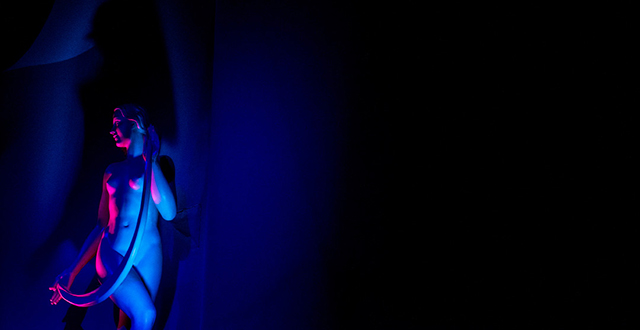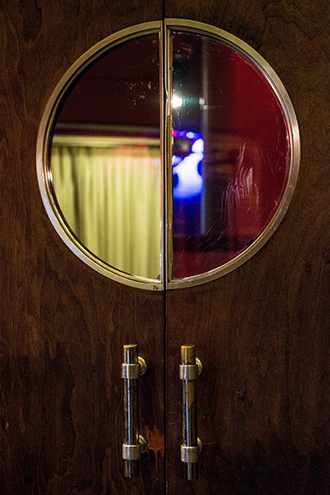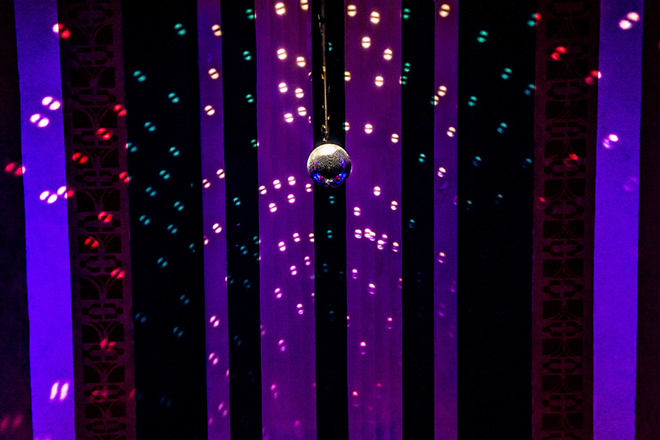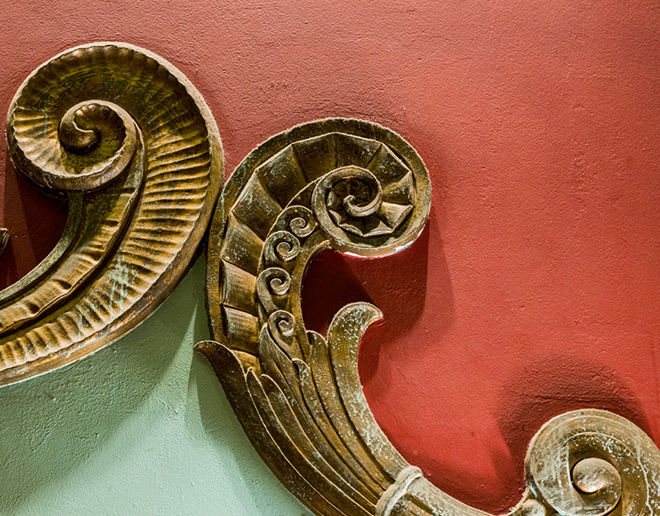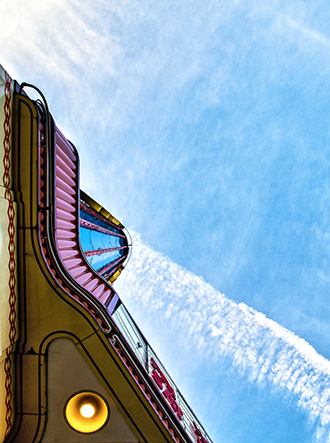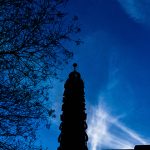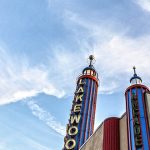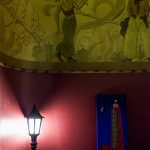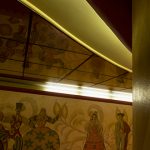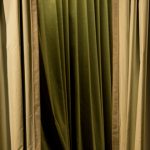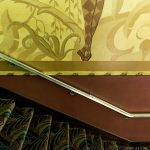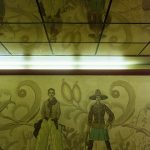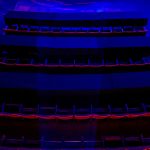Story by Brittany Nunn and Keri Mitchell
Lakewood has plenty of old churches, but not one that most everyone attends. The Lakewood Country club, established in 1912, predates most of the neighborhood’s homes, but membership is exclusive.
Neighbors have walked the halls of Woodrow Wilson High School since 1928, making it the logical connection between past, present and future generations.
But in terms of a neighborhood symbol, the obvious choice is the Lakewood Theater, and not just because of its emblematic 100-foot neon-lit tower.
“Nothing else represents Lakewood’s commercial history like that theater,” says East Dallas architect and preservationist Norman Alston. “In its time, the Lakewood Theater served the purpose for past generations as the one place everyone went, the place where people went out to see people and be seen. More than any other building in Lakewood, it embodies the history of the neighborhood.”
The question is what it’s worth — to neighbors, to the theater’s owners, to the City of Dallas — to preserve that history.
Karl Hoblitzelle spared no expense on the theater’s art deco design when he constructed the theater in 1938 at the tail end of the Great Depression. At the time, glamorous movie theaters peppered Dallas, and the Lakewood has outlasted most of its single-screen counterparts.
The tower’s neon lights have gone dark twice since it opened due to market shifts. But more than seven decades and four owners later, the theater has remained, essentially, a theater.
That is likely to change after this month, however. The current tenant’s lease is up at the end of January, and the theater’s owners have indicated a strong possibility that it will be carved up into two or three spaces to accommodate dining or retail tenants.
Craig Kinney, part of the Willingham -Rutledge partnership that purchased the southwest strip of the Lakewood shopping center in 2007, says the owners “would absolutely do nothing on that tower or change the exterior. That’s one of the reasons we bought it. It’s a great asset to us. Everybody knows the Lakewood Theater.”
People know the tower, certainly. It’s been the subject of hundreds of photographs, sketches and paintings, and has graced dozens of posters, T-shirts, coffee cups, magnets and the like. A Lego depiction of the tower made by fourth-graders at Lakewood Elementary was the top art sale at November’s Lakewood Home Festival auction party — $6,500.
The theater’s interior, however, is less familiar. Kinney says the owners are talking to a couple of theater groups, but it’s “probably a long shot at this point,” he says.
And its fate rests entirely in the hands of Kinney and the other owners.
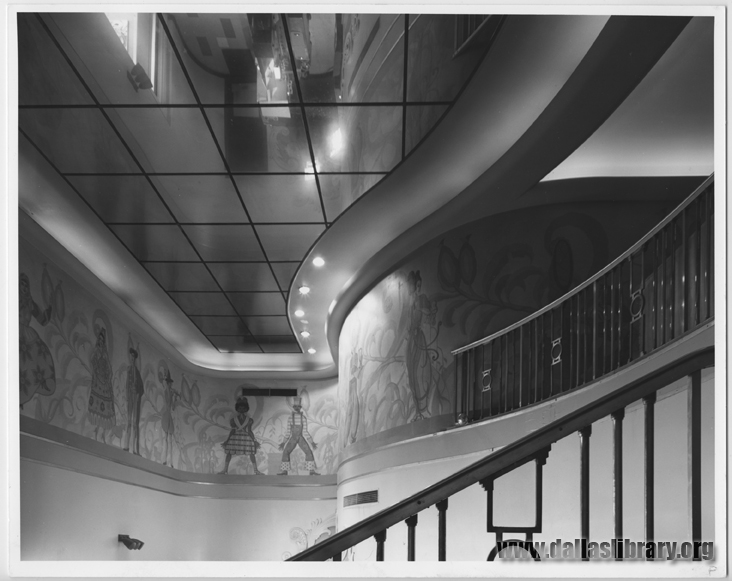
Lakewood Theater lobby, 1976: Collections of the Texas/Dallas History and Archives Division, Dallas Public Library
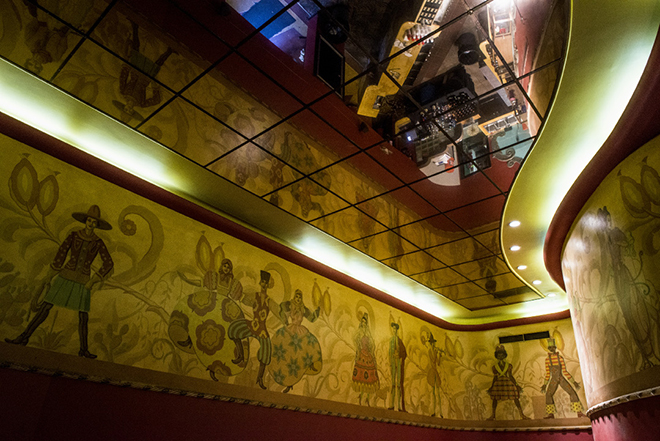
Then and now: The mural and mirrored ceiling in the lobby looks virtually unchanged since the top photo was taken in 1976. Karl Hoblitzelle, founder of Interstate Theaters, spared no expense on the Lakewood Theater’s design, which featured the bold Art Deco style typical of the era. Photo by Danny Fulgencio
A CAUSE LOOKING FOR A LEADER
If the theater’s owners wanted to demolish the building or turn it into lofts, they could. It has no protection, either in the City of Dallas zoning document that governs the property or in terms of historical or landmark designation.
When the Advocate published this news Nov. 7 on our online news site and Facebook page, the story went viral throughout the neighborhood. That same day, neighbor Krista Chalkley created a “Save the Lakewood Theater” Facebook page to garner support for its preservation. Within hours, the page received thousands of “likes” from neighbors — more than 2,700 in a single weekend, and more than 5,300 at last count.
Page administrators pointed out that the theater is still in use and makes a profit, and they described the owner’s decision to repurpose the space as “heartbreaking” because it is “a part of history” and “still making many memories within its walls.” They asked neighbors to share their favorite memories of the Lakewood Theater on the page, and more than 100 people obliged.
“I spent almost every Saturday at the Lakewood,” remembers Jan Lee. “I’m talking in the late ’50s. It was safe to be dropped off with a couple of friends and see two movies, cartoons in between, then a very short news reel.”
During intermission the theater gave out door prizes based on ticket numbers, Lee says, which included parakeets in cages or goldfish in a small glass bowl.
Laurie Kidder recalls her first job as a candy girl at the theater “wearing a red and white striped pinafore.”
“The purple, red and green iconic neon tower is like a beacon representing my home base in Dallas,” she says. “I loved the heavy red curtains, art deco interiors, the big swirling carpets, Disney murals and, of course, the feeling of belonging in this wonderful theater.”
But the momentum from the Facebook page lasted less than a week. We reached out to Chalkley several times but were unable to connect with her. On Nov. 12, five days after the page launched, an administrator commented, “Right now we are focused on the legal work involved, as it needs to be initiated quickly if we are to save the theater at all.”
And that was the final word from the “Save the Lakewood Theater” Facebook page. People continued to “like” the page and ask about the progress of preservation efforts, but questions went unanswered.
District 14 Councilman Philip Kingston says he has received a couple of concerned emails regarding the theater, but no volunteers for the legal legwork needed to halt significant changes to the structure.
“No one is taking the lead on this,” he says. “People are concerned, and rightly so, but no one is taking any real action.”
At any point, the City of Dallas could get involved and slow the process through a moratorium, which could legally prohibit the owners from being able to acquire a building permit for 30 days. Kingston continues to say he’s ready and willing to help in whatever way possible, but he won’t lead the charge.
“It’s going to take a real community effort,” he says.
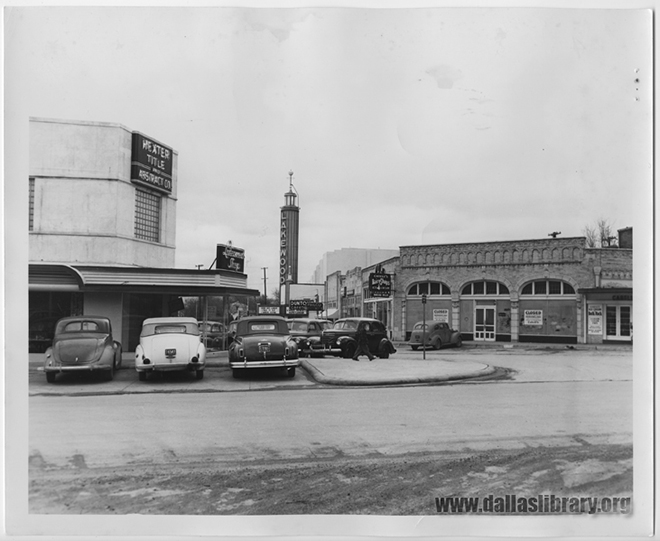
The Lakewood Shopping Center structures haven’t changed much since the’40s and ‘50s, but its tenants have — except for the Lakewood Theater. (Interstate Theatre Collection photo from the collections of the Texas/Dallas History and Archives Division, Dallas Public Library.)
THE MYTH OF HISTORICAL PROTECTION
Historical buildings are complicated. Perhaps no one in our neighborhood knows this better than Norman Alston, who for the last few years has steered his architecture firm toward addressing such structures. He received several awards in the early 2000s for the restoration of the Sears building, now known as the South Side on Lamar, and his most recent triumph was the circa-1931 U.S. Post Office and Courthouse building downtown, where he now offices.
But these types of restorations don’t happen without painstaking effort, and economic growth can be a threat.
“Downtown Lakewood has been its own little thing for some time now, without a lot of development pressure to do anything else there,” Alston says. “That’s changing.”
Believing that the Lakewood Theater, shopping center and other old neighborhood buildings are protected is a “common misunderstanding” and “completely not true,” Alston says.
The truth, he says, is that very little in our neighborhood is protected except some homes and churches. “And East Dallas is much better than the rest of the city,” he says.
It’s not too late for the Lakewood Theater to be designated a historic landmark by the city, which would protect its exterior. But at press time, despite the social media outcry, no one had initiated this process via the Landmark Commission, says Mark Doty, who works with historic preservation in the city.
Plus, the support of the owners would be fairly crucial to achieve such a designation, Doty says, because the process includes not only ensuring the preservation of the structure but also meeting the owner’s needs.
Kinney says Willingham-Rutledge may be open to this, but not yet.
“Until I know what my tenant is, I don’t know where I am,” Kinney says.
As he has stated, however, the owners intend to maintain the theater’s exterior, regardless of landmark designation. This assertation quickly followed the news of the structure’s vulnerability, and may have quelled the urgency in efforts to preserve the theater.
Alston argues, however, that the tower and marquee are not the only parts of the theater that should be protected.
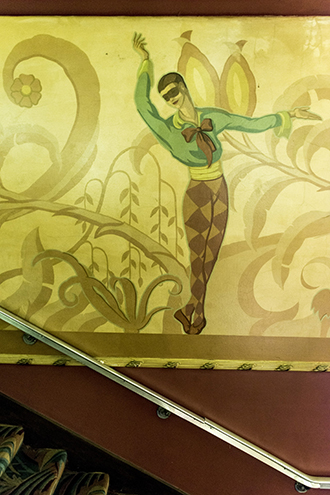
A dancer in third position guides theater-goers up the stairs to the balcony: Photo by Danny Fulgencio
The memories that were made at the Lakewood Theater happened inside the building, Alston says. For some, it was a first job, a first date, a first kiss. In its early years, the theater was host not only to Hollywood films but also to ladies’ book reviews, Woodrow Wilson High School graduation parties and even private birthday parties. After a fire destroyed the Lakewood Methodist Church sanctuary in January 1960, the congregation worshipped at the theater until it could be restored.
“The building is part of the urban fabric,” Alston says. “If you’re looking at a history of things that happened there, it involved the entire building. If you just save a piece of it, is that any different than taking a picture?”
Retaining the exterior but overhauling the interior is not preservation, Alston says — it’s a “façade-ectomy.”
“The idea of preserving only the tower is not preserving it at all,” Alston says. “Seeing just the tower would just remind you of what you’ve lost.”
Alston readily admits that he “drinks the purple Kool-Aid of preservation.” He has served two terms as a city landmark commissioner, spent the last 20-plus years chairing historic-district task forces (currently Peak’s Suburban), and overseen the restoration of several historical homes and buildings, and he sits on the Preservation Dallas preservation issues task force. His views are at the extreme end of the preservation spectrum and also, as it appears in the case of the Lakewood Theater, in the minority.
Alston says he won’t be taking the lead to preserve the theater. He has too many other projects on his plate, plus he wants to give younger generations a chance to take up these kinds of issues. Old buildings are too often seen as a concern of old people, he says.
“If you’re ever going to have a history, you can’t tear it all down,” Alston says. “We’re so entrepreneurial here [in Dallas], and that’s good, but ‘old is bad and new is good’ … I think that way of thinking is dated.”
A NUMBERS GAME
Landmark and historical designations are something of a “stick” for developers, Alston says, but there are “carrots,” too. Major federal and state tax credits that amount to 45 percent of restoration costs incentivize the owners of historical buildings to preserve them, both inside and out.
“There’s a detailed list of things you can and cannot do” to secure these credits, Alston says. For example, the owners most likely would be required to protect any murals left on the walls, as well as windows, doors and other period features.
Alston says it would be difficult to preserve the integrity of the Lakewood Theater enough to qualify for the credits and still repurpose it as anything other than a theater-type use. But, in his opinion, that’s basically the point.
“It’s a physical remnant of another time,” he says. “Some things can be changed, but how do you keep that thread of history running through your community? The Lakewood Theater is the main strand of that thread.”
Limiting the structure to a theater, however, is the very reason Kinney says Willingham -Rutledge wouldn’t be interested in pursuing the tax credits.
“If the theater didn’t make it in three years, then we’d be in the soup,” Kinney says.
Other single-screen neighborhood theaters in Dallas have managed to find a sustainable operation. The Texas Theatre in Oak Cliff operates as both a movie theater and event venue. Also in Oak Cliff, the long-abandoned Kessler Theater has been operating as a concert venue since 2009.
Alston and other preservationists point to these theaters as the ideal modern re-use of a historical theater. But reality, as it tends to be, is more complicated.
In East Dallas, Mike Schoder bought the historic Granada Theater on Greenville Avenue 10 years ago and is responsible for the success behind its current operation as a concert venue. Although he thinks it’s a shame to see another historic theater bite the dust, he says running a 1930s, single-screen theater tucked away in the middle of a neighborhood is as hard as it sounds.
“It takes so much effort to have something like the Granada or the Lakewood and make it profitable,” he says. “It’s just nonstop. There’s a lot of competition in the market.”
Dallas has “as many music venues as it can support,” in his opinion. Plus, “trying to pack it out and get 700 people, where do you park them all?” he questions. “It’s a tough little area there.”
Converting it back to a movie theater would be just as tough, if not tougher, says Barak Epstein with the Texas Theatre. The only way the Texas stays afloat is by also booking concerts, comedy and live performances, and renting out the theater for events, he says.
Epstein figures the owners of the Lakewood Theater are probably trying to increase the space’s use.
“Unfortunately, it may mean breaking it up,” Epstein says. “I think ultimately there is a happy medium that could come about if the building owner and the prospective tenants come to a reasonable agreement on a lease that would increase the viability of the theater — as a movie theater, venue, bar, etc. — as well as give a boost to the surrounding tenants and the neighborhood.”
A number of restaurants have expressed interest in the theater space, Kinney says, and the owners are talking to two theater groups as well, one of which might purchase the theater.
“If either one commits, we’re going to try to do one of those deals,” he says. “It’s much easier, and we think it’s good for Lakewood.”
The group interested in purchasing might also be interested in historical preservation, he says. But the theater deals may not pan out, and even if they do, the restaurants may be able to offer higher rent, which Kinney says would likely sway the owners.
As unromantic as it sounds, Schoder says, the future of the Lakewood Theater is a numbers game.
“It’s sad, but it’s reality,” he says. “I’m sure the neighborhood would hate to see it go, but it would probably be better used as a couple of restaurants, because it hasn’t been used in so long as much of anything. I’ve probably only seen four shows there since I moved here in ’86, and I’m a show fiend.”
AN ‘OUTSIDE’ PERSPECTIVE
The Lakewood hasn’t operated solely as a movie theater since 1993 — the last time it went dark. It reopened in ’94 as more of an event space as well as a concert venue.
These days, it’s more of a stage theater than a movie theater, but it does show the occasional documentary or classic. Its mainstay monthly bookings are Viva Dallas Burlesque and the Rocky Horror Picture Show. Concerts have been few and far between lately, save for the annual holiday performances last month from neighbors Ricki Derek, Kelly Brown and Polyphonic Spree frontman Tim DeLaughter.
Longtime neighbor Gerry Worrall believes the reason the Lakewood has lasted this long “probably has more to do with management than it has to do with luck. These guys have done a pretty creative job in terms of the different types of uses it has had.”
Worrall, an architect, owns the Diener-Mills building across the street from the Lakewood Theater at the center of the Lakewood Shopping Center; Worrall’s building once housed the Lakewood Branch Library. The building is named for Paul Diener and Cecil Mills, who bought the building when it was scheduled for destruction in the ’80s.
“There were several buildings in the community on the chopping block or in need of some care, and their desire was to make sure that it remained and that it was useful long-term,” he says of Diener and Mills.
Worrall shares the perspective of his building’s namesakes when it comes to the Lakewood Theater. He saw movies there over the years, and even temporarily attended church there with his grandparents, members of Lakewood Methodist.
He isn’t among those hoping the Lakewood will return to its roots as a movie theater, however.
“It’s a quaint idea, but it’s a thing of the past,” Worrall says.
Nor does Worrall think the neighborhood should stand in the way of progress, so to speak.
“What I would hate to see are enough restrictions put on the site so the owner can’t make a viable business operate there,” he says. “We could end up with a vacant shell there that would be anything but positive for the neighborhood.”
Like most neighbors, Worrall values the character of the theater’s exterior and thinks retaining it is important. But trying to dictate the process of what happens inside may jeopardize the outside, he says.
“If we go down and try to create a bunch of barriers, I think long-term, we’re asking for some trouble,” Worrall says.
Flexibility and opportunity for the owners are what Worrall wants, even though that may well result in the Lakewood dropping “theater” from its name. Worrall’s perspective is different from that of Alston, who believes commercial success and preservation success can go hand in hand.
“They’re not incompatible,” Alston says. “If you want to do it, it can be done.”
Where there’s a will there’s a way, in other words. Other than a few lone voices, however, and some flash-in-the-pan social media indignation, there doesn’t appear to be a will — not among neighbors, not from the owners and not on the part of the city.
“It’s at an age now, and has gone through enough recycles, that it needs some new capital behind it,” Worrall says of the Lakewood Theater.
“Certainly, there are a variety of possibilities.”

